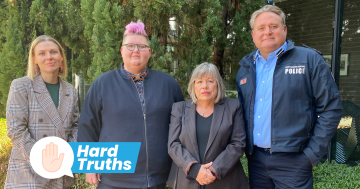
Intimate image abuse is a rising concern among young Australians, but there are ways we can help.
With the changes to image sharing laws in the ACT in August, it’s important that young people know what’s legal and what to do if things go wrong. Despite opinions others might have about what “kids these days” should or should not do, the fact is that 55% of 18 to 29-year-old Australians have sent a nude selfie.
In addition to finding out how common it is for Australians to share intimate images, the study by RMIT and Monash University into intimate image sharing found that 1 in 5 Australians aged 16 to 49 had experienced non-consensual creation of nude or sexual images, 11% had experienced non-consensual sharing of images, and 9% had been threatened with non-consensual sharing of images. Young people aged 16 to 29 years are the most likely to be victims of this kind of abuse. Indigenous people and people with a disability are also more likely to have experienced abuse.
For parents or carers of young people, conversations about sex and sexuality can be pretty awkward, but we can’t just assume they’ll magically know about their rights and how to protect themselves. The kids are going to think we’re all old dags whether we have the talk or not. Better to have the conversation and at least know they’ve got accurate information on their rights, and who to talk to if they need help. And we need to talk to boys and girls.
The Women’s Centre for Health Matters and Canberra Rape Crisis Centre created the What To Say website and You Can’t Share That! campaigns to help, including resources for students and fact sheets. Here are some more tips for talking about intimate images with your young person:
Don’t victim-blame
If someone shares an intimate image without the consent of the person in the image, it’s a crime committed by the person who shared the image. Not by the person in the image.
There is nothing wrong with expecting trust, love, and respect from the people they are in relationships with. There are a lot of things wrong with someone violating that trust and respect by taking or sharing images without consent.
Instead of responding with “what did you expect would happen?”, try looking at it from the point of view of a young person feeling hurt by someone who should have shown them more respect.
It is OK for young people to communicate sexually with each other, but there must be consent.
What does the law say?
In the ACT, we have specific legislation dealing with intimate images. This includes images (stills or video) of a person’s private parts, whether naked or covered by underwear. It also covers a person engaged in an act for which they could reasonably expect privacy, such as undressing, using a toilet or showering, or engaging in sexual activity that would normally not be done in public. Intimate images also include an image that has been altered so that it looks like you can see a person’s private parts, or looks like the person is engaging in a private act.
You can only take or share an intimate image in the ACT if the person shown in the image consents to it. Making an image, distributing it, or threatening to make or distribute an intimate image without consent can result in up to 3 years in jail, or a $45,000 fine.
The laws about consent are very specific when it comes to young people. People under 16 are too young to give consent to anyone other than another young person within two years of their own age, and people under 14 are too young to give consent at all. So if a young person is 14, they can give consent to someone up to age 16. Or if they’re 16, they can give consent to someone up to 18 years old. But if they’re under 14, there is no such thing as consent. This is consistent with other laws about sexual relationships between young people. It’s intended to protect teenagers who are consenting with each other but still protect them from exploitation.
It’s important for young people to know what the law says so that they know when someone is breaking the law, and that it is taken seriously by police and the courts.
How does consent even work?
Just as with any other sexual activity, consent is important. It’s consent when it’s given freely, by someone who is able.
It’s good to talk about how to be clear about what they are giving consent to, or what they are asking for consent for.
How will the other person know that this image is just for them, and not for sharing with their friends?
Are they sure that the person they asked for an image from is comfortable sharing it, or might they feel like the relationship could be over if they say no?
If someone says yes to a request for a nude selfie but they’re underage, it’s not consent. It’s child porn, and it’s illegal.
If someone is affected by alcohol or drugs, saying yes is not consent.
If someone is asleep or unconscious or doesn’t know they’re being filmed, there is no consent.
If they’re only saying yes because they’re worried the other person will do something to embarrass, humiliate, or hurt them if they don’t, it’s not consent. It’s blackmail, and it’s illegal.
It’s also good to talk about how to respond to a request if they want to say no. Particularly for people who have been taught to be nice and polite and not hurt other people’s feelings, it’s important to know that their body is their own, and they have the right to say no.
Encouraging young people to think critically about what could go wrong is an important part of any activity that carries risk. It can help them to come up with ways to make it clear when they’re consenting, and what they’re consenting to. It can also help them be clear in their own minds about what they don’t want to give consent to, and how to communicate that.
Feeling awkward talking about consent with a young person? Try showing them this video about getting consent for a cup of tea.
When things go wrong
Firstly, tell someone who can be supportive and helpful. That might be a parent, school, a counselling service, or police.
Supporting someone who tells you that they have experienced image based abuse means listening without judgement, believing them, asking them what they would like you to do, and encouraging them to get help from services who know what to do in this situation (listed below).
The new laws include the ability for the court to order images to be taken down or destroyed, with penalties of up to 2 years in jail or a $30,000 fine for failure to comply with the court order. But of course, once it’s on the internet it’s very hard to get rid of it.
More resources on What To Say and You Can’t Share That!
Report image-based abuse: https://www.esafety.gov.au/image-based-abuse
If you have experienced intimate image abuse and want to talk to someone about it, you can contact:
- Canberra Rape Crisis Centre on 6247 2525
- 1800RESPECT on 1800 737 732
- Domestic Violence Crisis Service on 6280 0900
- Victim Support ACT
Do you know of any other support services for victims of intimate image abuse or related abuses? Please share their details with us by commenting below.





















